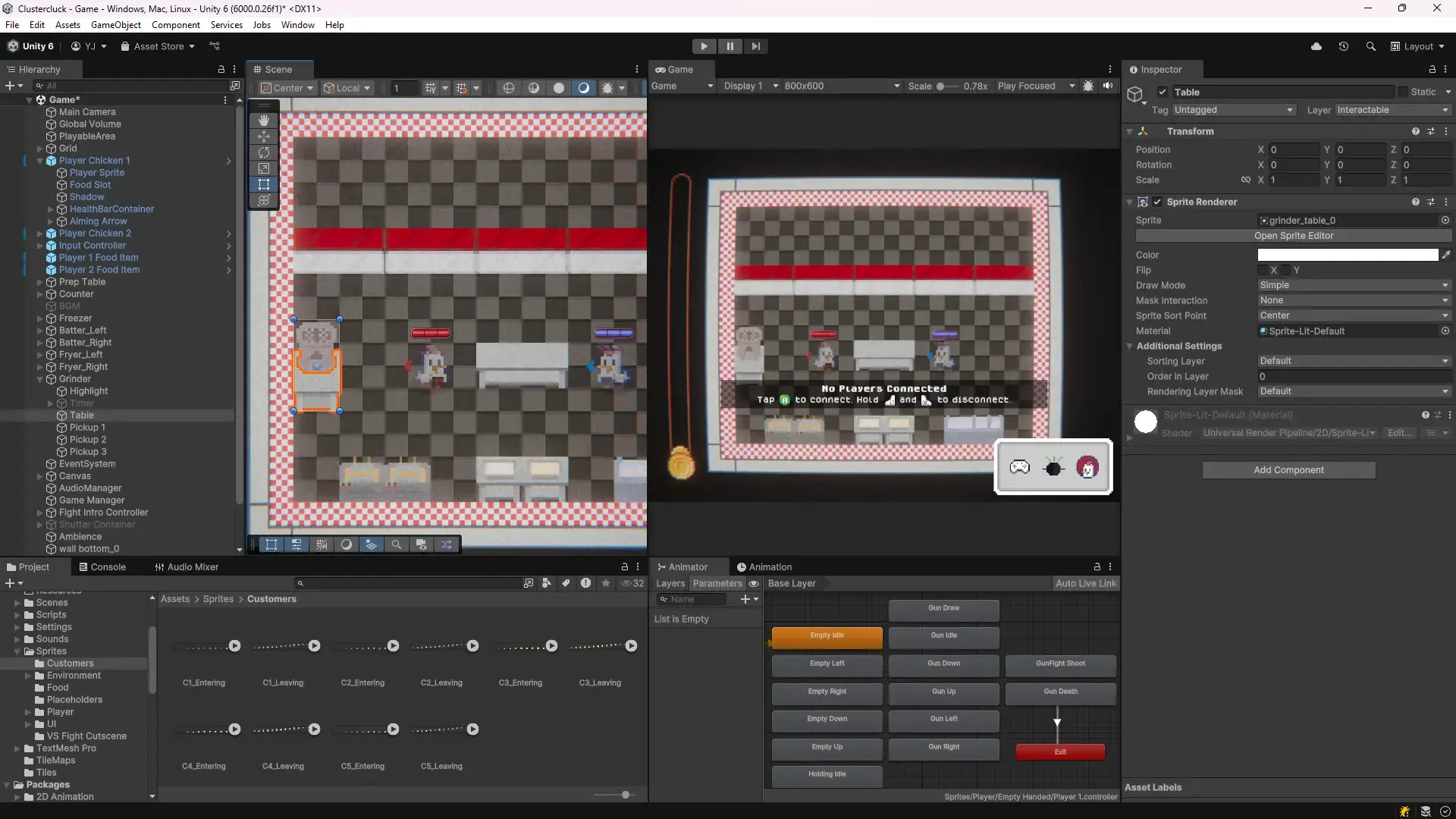Clustercluck was developed by a team focused on delivering an original, engaging, and polished prototype that combined narrative-driven gameplay with cooperative mechanics, built in Unity.
As the Technical Artist, I worked closely with designers and artists to ensure sprite consistency and handled asset integration into the game engine. With a tight production schedule, I focused on building responsive systems that showcased the art assets, rather than requiring the artists to adapt to rigid systems — a decision that helped us avoid over-scoping and reduce wasted effort. I also contributed to early gameplay programming and integrated controller support, adding a layer of fun and shared chaos that enhanced the game’s cooperative experience.

We initially built the level layout around a strict tilemap system, where every element, from floors to interactable items, was confined to a grid. While this made early layout and level design easier, we soon found that interactable items didn’t fit neatly into our programming workflow, leading to implementation and debugging challenges. To solve this, I kept the tilemap system for visual layout and static elements like floors and walls, but transitioned interactable items to a separate free-form placement system. This shift significantly reduced debugging overhead while still preserving the original tiled aesthetic and spatial logic that the interactable items were designed around.

Controller support was integrated from the start as a deliberate design decision to support the game’s cooperative nature. The analog inputs allowed for smoother and more precise movement, which was especially important for gameplay that required quick reactions and coordination. In a shared multiplayer setting, using gamepads felt more natural — players sitting side by side, each with a controller in hand, reinforced the social and collaborative aspect of the game beyond just storytelling or mechanics.
I built upon Unity's Input System to include support for two players, writing custom scripts to handle simultaneous inputs without conflict.
I ensured that core gameplay systems such as movement responded intuitively to gamepad input.
Clustercluck was developed by a team focused on delivering an original, engaging, and polished prototype that combined narrative-driven gameplay with cooperative mechanics, built in Unity.
As the Technical Artist, I worked closely with designers and artists to ensure sprite consistency and handled asset integration into the game engine. With a tight production schedule, I focused on building responsive systems that showcased the art assets, rather than requiring the artists to adapt to rigid systems — a decision that helped us avoid over-scoping and reduce wasted effort. I also contributed to early gameplay programming and integrated controller support, adding a layer of fun and shared chaos that enhanced the game’s cooperative experience.

We initially built the level layout around a strict tilemap system, where every element, from floors to interactable items, was confined to a grid. While this made early layout and level design easier, we soon found that interactable items didn’t fit neatly into our programming workflow, leading to implementation and debugging challenges. To solve this, I kept the tilemap system for visual layout and static elements like floors and walls, but transitioned interactable items to a separate free-form placement system. This shift significantly reduced debugging overhead while still preserving the original tiled aesthetic and spatial logic that the interactable items were designed around.

Controller support was integrated from the start as a deliberate design decision to support the game’s cooperative nature. The analog inputs allowed for smoother and more precise movement, which was especially important for gameplay that required quick reactions and coordination. In a shared multiplayer setting, using gamepads felt more natural — players sitting side by side, each with a controller in hand, reinforced the social and collaborative aspect of the game beyond just storytelling or mechanics.
I built upon Unity's Input System to include support for two players, writing custom scripts to handle simultaneous inputs without conflict.
I ensured that core gameplay systems such as movement responded intuitively to gamepad input.